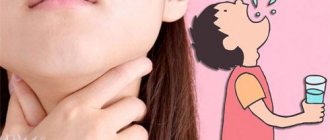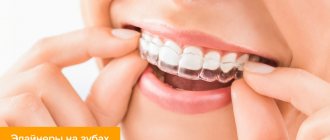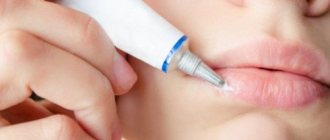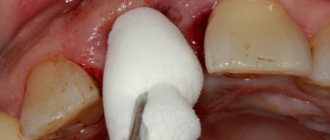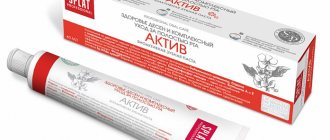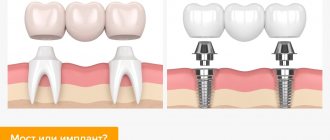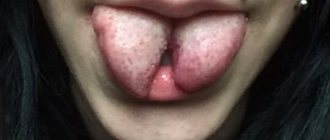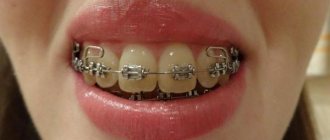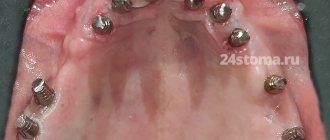The main risk factors for the development of candidiasis include:
- improper oral hygiene;
- wearing orthopedic structures or removable dentures;
- long-term inhalation therapy;
- decreased salivation due to certain pathologies;
- hypothermia;
- stress;
- taking antibiotics;
- changes in hormonal levels;
- decreased immunity, including due to chronic diseases;
- endocrine pathologies, including obesity, diabetes;
- smoking;
- carrying out chemotherapy or radiation therapy.
Oral candidiasis occurs much more often in children than in adults. Newborns can become infected even in utero if the mother has thrush - infection occurs during natural childbirth. After birth, the infection can be transmitted to the child through the skin of the mother's nipples and hands, and from her oral mucosa. The source of infection is unsterile pacifiers and oilcloths, and medical personnel who do not follow the rules of asepsis and antisepsis during invasive procedures. In an older child, oral candidiasis is often caused by a weakened immune system or improper dental care.
Clotrimazole solution for external use 10 mg/1 ml 25 ml No. 1
Name
Clotrimazole solution dnar. approx. 10mg1ml in vial. 25ml pack No. 1
Description
Transparent, colorless liquid with a characteristic odor.
Main active ingredient
Clotrimazole
Release form
solution
Dosage
25ml
Indications for use
Mycoses of the feet, nails (onychomycosis), palms. Dermatomycosis of the head, torso, groin areas, trichophytosis. Pityriasis versicolor and erythrasma.
Directions for use and doses
For external use. Gently rub a few drops of liquid into the affected areas of the skin 2-3 times a day. After eliminating the acute symptoms of the disease, treatment should be continued for at least another 4 weeks until the symptoms are completely relieved. For tinea pedis, the drug should be used for another two weeks after the symptoms of the disease have resolved. After washing, feet should be thoroughly dried, especially between the toes. For tinea pedis, it is recommended to use the solution after each wash. Children In children under 11 years of age, the drug can be used after consultation with a doctor. Patients with renal and hepatic insufficiency Studies of the use of the drug in patients with insufficiency of renal and hepatic function have not been conducted. There is no information on dosing specifics for this group of patients. Use in geriatric practice Appropriate studies of the relationship between age and the effect of topical use of clotrimazole in the geriatric population have not been conducted. There is no information on dosing specifics in elderly patients. Use in elderly patients requires caution.
Use during pregnancy and lactation
Studies on the safety of using the drug applied topically to the skin during pregnancy and breastfeeding have not been conducted. The use of the drug in the first trimester of pregnancy is not recommended. Caution should be exercised when using clotrimazole after the first trimester and during breastfeeding.
Precautionary measures
Itchy, painfully changed areas should not be scratched or scratched, as this causes the disease to spread. Avoid contact with eyes and mucous membranes. Avoid use in the eye area as it may cause irritation. In case of accidental contact with eyes, rinse with running water for several minutes. Do not wear clothes and shoes that do not allow moisture and heat to pass through. After washing, dry painful areas thoroughly. Clothing that covers painful areas and towels should be changed daily and washed at 90°C (use of disposable towels is recommended). Ethanol, which is part of the drug (70% vol.), is partially absorbed through the skin and mucous membranes when used externally, therefore the use of an alcohol solution of clotrimazole in children, pregnant women and women during lactation is not recommended, and use in elderly patients requires caution.
Interaction with other drugs
Clotrimazole may inhibit the effect of other topical antifungal drugs, especially polyene antibiotics such as nystatin and natamycin, and reduce the effects of amphotericin B. Topically applied corticosteroids inhibit the antifungal effect of clotrimazole.
Contraindications
Hypersensitivity to clotrimazole and/or other components of the drug. I trimester of pregnancy. Use with occlusive dressing. Do not use in the eye area. Do not use internally. Acute inflammatory processes with violation of the integrity of the skin.
Compound
1 ml of solution contains: active ingredient: clotrimazole 10 mg, excipients: isopropyl myristate, anhydrous ethanol (70% vol.).
Overdose
There are no data on cases of overdose of clotrimazole when used externally. In case of unintentional ingestion of clotrimazole, usual measures, such as gastric lavage, should only be taken if clinical symptoms of overdose (such as dizziness, nausea or vomiting) occur. If performed, the respiratory tract must be properly protected.
Side effect
In rare cases, a local allergic reaction, burning, itching, or minor irritation at the site of application of the drug may occur. Very rarely: extensive erythema, rash, swelling, urticaria, peeling of the epidermis. When used externally, the alcohol included in the drug (70% vol.) is partially absorbed through the skin and mucous membranes and can have a resorptive general toxic effect (CNS depression). Inhalation of vapors may cause drowsiness and headache.
Storage conditions
Store in a place protected from moisture, at a temperature not exceeding 25°C in the original packaging. Keep out of the reach of children.
Oral candidiasis is divided into 3 types:
- Pseudomembranous. This is a classic thrush in the form of a superficial white film or white spots. Accompanied by a feeling of slight discomfort. In mild forms of the disease there may be only a few such plaques, and they can be easily removed. In severe cases, many large spots appear, they merge and gradually affect the entire mucous membrane, and can penetrate lower, affecting first the throat, and then the esophagus, up to the gastrointestinal tract. The spots may thicken, making them difficult to remove. Most often, ordinary acute candidiasis occurs in adults who have taken antibiotics, immunosuppressants or corticosteroids, as well as in infants.
- Atrophic. It can be acute or chronic. In the first case, there may be no plaque, but the mucous membrane becomes inflamed - it becomes bright red, the patient complains of a strong burning sensation in the mouth, increased dryness, and sometimes an unpleasant taste with a hint of bitterness or metal. Most often, acute candidiasis is a consequence of drug therapy. The chronic form usually occurs due to wearing orthodontic structures or dentures. The symptoms of the disease are more subtle.
- Hyperplastic. Candidiasis in the mouth affects the lips, corners of the mouth, cheeks, soft palate, and back of the tongue. White spots are usually large, merge with each other, and may acquire a yellow tint. Gradually they become rough and cannot be scraped off. The disease is chronic and is diagnosed only in adults.
Treatment of candidiasis in the mouth
There are several types of candidiasis of the oral mucosa, but treatment tactics do not differ significantly.
The most commonly used drugs for oral candidiasis are local antimycotics in the form of aerosols, solutions, gels, for example, fenticonazole, miconazole or amphotericin B.
Additionally, antiseptics with antifungal activity are used in the form of solutions for rinsing or lubricating lesions. For rinsing, preparations based on hexetidine and chlorhexidine are often used. A good medicine for candidiasis in the mouth is Lugol's solution, it is used to lubricate plaques.
To strengthen the immune system, it is recommended to take vitamins, especially C, P and group B.
Oral and even infusional antifungal antibiotics for oral candidiasis (sertaconazole, miconazole, isoconazole) are required for severe or chronic disease.
It is important that during the therapy period patients follow a diet that excludes fast carbohydrates (all types of sweets), since they are an excellent breeding ground for candida. Patients should refrain from eating sour and spicy foods.
When treating oral candidiasis in children, it is recommended to carry out “alkalinization” - treating pacifiers, bottles and toys that the baby may put in the mouth with a baking soda solution.
Clotrimazole
Clotrimazole
(Latin
Clotrimazolum
, English
clotrimazole
) is a broad-spectrum antifungal drug, an imidazole derivative. Acts mainly on microorganisms in the stage of division and growth. Clotrimazole is poorly absorbed when taken orally, it cannot be administered parenterally and is used almost exclusively for the local treatment of diseases of the oral cavity, skin and gynecological diseases.
Clotrimazole is a chemical compound
The chemical name of clotrimazole is 1-[(2-chlorophenyl)diphenylmethyl]-1H-imidazole.
The empirical formula of clotrimazole is C22H17ClN2. Molecular weight 345 g/mol. White crystalline substance, odorless. Almost insoluble in water, slightly soluble in ether, very soluble in ethanol and polyethylene glycol 400.
Microorganisms against which clotrimazole is active or inactive
Mushrooms:
- Clotrimazole is active against yeast fungi: Candida spp.
(including
Candida albicans
and
Candida glabrata
(
Torulopsis glabrata
) and excluding
Candida guillermondii
),
Rhodotorula spp., Malassezia furfur (Pityrosporum orbiculare), Blastomyces dermatitidis - active against dermatophytes: Trichophyton rubrum, Trichophyton mentagrophytes, Epidermophyton floccosum, Arthroderma otae (Microsporum canis)
- Clotrimazole resistant: Candida guillermondii
Bacteria:
- clotrimazole has antibacterial activity in vitro against strains of gram-positive bacteria: Staphylococcus spp.
(including
Staphylococcus aureus), Streptococcus spp
.
(including Streptococcus pyogenes), Proteus vulgaris, Corynebacterium minutissimum, Salmonella spp. - clotrimazole is active against gram-negative (gram-variable) bacteria: Bacteroides spp., Gardnerella vaginalis
- resistant to clotrimazole: Escherichia coli, Klebsiella pneumoniae, Proteus mirabilis
and
Pseudomonas aeruginosa
Protists: Clotrimazole in high concentrations is active against Trichomonas vaginalis
.
Clotrimazole in ATC
Clotrimazole is the international nonproprietary name (INN) of the drug. In ATC, clotrimazole is included in a number of different groups, each of which has its own code, in particular:
- "A01 Dental preparations", "A01AB Antimicrobial preparations for local treatment of diseases of the oral cavity", code A01AB18
- "D01 Antifungal drugs for the treatment of skin diseases", "D01AC Imidazole and triazole derivatives", code D01AC01
- “G01 Antiseptics and antimicrobials for the treatment of gynecological diseases”, “G01AF Imidazole derivatives”, code G01AF02
Indications for use of clotrimazole
Clotrimazole is indicated for diseases of the skin, oral cavity, mucous membranes of the female and male genital organs with microorganisms sensitive to it:
- fungal infections of the skin and mucous membranes: dermatomycosis, dermatophytosis, trichophytosis, epidermophytosis, microsporia, candidiasis, stomatitis, interdigital fungal erosion, fungal paronychia
- candidiasis vulvitis, vulvovaginitis
- balanitis, balanoposthitis
- trichomoniasis
- lichen: pityriasis versicolor or versicolor
- erythrasma
- mycoses complicated by secondary pyoderma
Order of use of clotrimazole and dose
Fungal skin infections, erythrasma, lichen
. Clotrimazole ointment, cream or solution is applied in a thin layer to the affected areas of the skin and mucous membranes 2-4 times a day and rubbed in gently. The duration of therapy is about 4 weeks, or until the clinical manifestations disappear and another 2 weeks (for fungal infections of the legs - 2-3 weeks).
In the treatment of oral
: 0.5–1 ml (10–20 drops) of clotrimazole solution, using, for example, a cotton swab, is applied to the affected areas of the oral mucosa 3-4 times a day.
At least 3-5 days of treatment; Duration of treatment: from 3 or more days until complete recovery.
Mild balanoposthitis
Balanitis, vulvitis
. 2-3 times a day for 1-2 weeks - clotrimazole ointment, cream or solution.
Vaginitis, trichomoniasis
. Vaginal tablets are inserted deep into the vagina, once a day, in the evening: either 6-7 days, 100 mg of clotrimazole, or 3 days, 200 mg of clotrimazole, or 1 day, 500 mg of clotrimazole. The cream, a full applicator, is inserted into the vagina as deeply as possible once a day, before bedtime.
Candidal esophagitis
. Clotrimazole 10 mg tablets, sucked every 6 hours (Harrison's Handbook of Internal Medicine).
Sanitation of the birth canal
- 1 tablet of clotrimazole once.
In the absence of clinical effect
within 4 weeks, a repeated study is required to determine the infectious agent.
Use of clotrimazole in pregnant and nursing mothers
The FDA risk category for the use of clotrimazole in pregnant women is B (animal studies have not revealed a risk of adverse effects on the fetus; there have been no adequate studies in pregnant women).
It is not recommended to use clotrimazole in the first trimester of pregnancy. In the II-III trimesters, it is not recommended to use intravaginal applicators. Since there are no reliable studies confirming or refuting the excretion of clotrimazole into breast milk, therapy with clotrimazole for nursing mothers is not recommended.
Trade names of drugs with the active substance clotrimazole
The following drugs with the active substance clotrimazole are (have been) registered in Russia: Amyclone, Antifungol, Gine-Lotrimin, Imidil, Yenamazol 100, Candibene, Candid, Candid-B6, Candizol, Kanesten, Kanizon, Clotrimazole, Clotrimazole-Acri, Clotrimazole-Teva , Lotrimin, Faktodin.
See also (pdf): “Instructions for use of the drug for medical use Clotrimazole-Teva.”
Clotrimazole has contraindications and side effects; before use, consultation with a specialist is necessary.
Back to section
Prevention
To prevent the development of the disease, you should carefully monitor the condition of the oral cavity. Every person is recommended to undergo a preventive examination at the dentist once a year and have their teeth treated on time. People who wear dentures should do so more often. Smoking is also one of the causes of thrush, so it is advisable to give up this bad habit.
During the period of antibiotic therapy, it is necessary to take eubiotics to correct the intestinal microflora.
Popular questions about candidiasis
How to determine candidiasis?
The disease has a specific symptom - white plaque in different parts of the oral cavity.
Which doctor treats oral candidiasis?
Dentist-therapist.
How is candidiasis treated?
Doctors usually prescribe the following medications to treat oral thrush: chlorhexidine or hexetidine solution, as well as nystatin, amphotericin B, or miconazole. They are available in different dosage forms (in the form of a gel, solution, aerosol), everyone will choose the one that is convenient for themselves.
Analogs
Drug analogues
Clotrimazole is also known under such trade names as Amyclone, Imidil, Candibene, Candide, Candizol, Kanesten, Kanizon, Funginal, Fungicip.
When deciding on the choice of ointment or cream, you should first of all proceed from the amount of active substance per unit volume of the dosage form.

